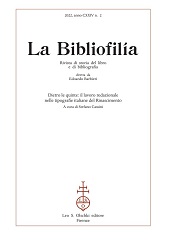Compilatori e tipografi all'opera : le edizioni italiane della Polyanthea
P. 265-278
Textual production in the early modern period is inherently linked to the use of reference books. These works served as an everyday support to conveniently manage and access an ever-increasing record of scholarly sources. This article investigates the working methods and synergies of the different professional figures involved in compiling and printing one of the most popular florilegia throughout the sixteenth and seventeenth centuries.
The transformations of the Polyanthea by Domenico Nani Mirabelli are traced by examining its Italian editions, starting from the editio princeps (Savona, Francesco Silva, 1503), through the arrival of the book in the major Italian printing centre (Venice, Rusconi, 1507; Liechtenstein, 1507), the author's revised edition (Savona, Simone Bevilacqua, 1514), up to the return of the Polyanthea to the Venetian press after its European success and the revisions carried out by various compilers and printers (Venice, Giovanni Battista Ciotti, 1592; Giovanni Guerigli, 1607; 1616; 1622; 1623; Paolo Guerigli, 1630). The organizational aspects of the Polyanthea are also addressed, as well as the many compilatory sources behind the text. [Publisher's text]
-
Artículos del mismo número (disponibles individualmente)
-
Información
Código DOI: 10.1400/291859
ISSN: 2035-6110


